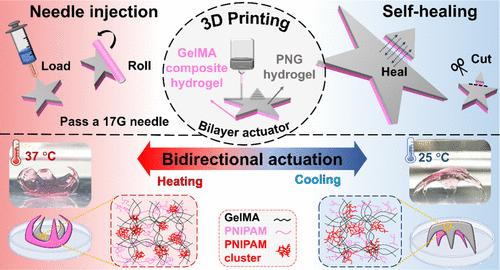一种生物相容性和自我修复的3d打印双向水凝胶致动器,具有针注射性
IF 8.2
2区 材料科学
Q1 MATERIALS SCIENCE, MULTIDISCIPLINARY
引用次数: 0
摘要
多功能水凝胶在新兴材料应用中是非常理想的,特别是生物相容性水凝胶驱动器。然而,将韧性、自我修复和可逆的双向驱动整合到生物相容的驱动器中仍然是一个挑战。本文以新型聚(n -异丙基丙烯酰胺)-明胶甲基丙烯酰(PNIPAM-GelMA;“PNG”)水凝胶为活性层,开发了一种具有可逆双向驱动的可3d打印生物相容性双层水凝胶致动器。光交联的PNG水凝胶具有自愈能力和良好的弹性(存储模量~ 13 kPa)和韧性(线性粘弹性范围可达240%剪切应变)。对PNG微观结构的小角度x射线散射分析揭示了由互锁PNIPAM侧链组成的动态PNIPAM团簇的存在,这说明了PNG水凝胶的自修复行为。以PNG为主动层,GelMA为被动层的3d打印双层致动器具有双向致动性和良好的针注射性。此外,将PNG活性层与自愈合的被动层(例如,聚氨酯- gelma复合水凝胶)配对可以产生自愈合的致动器。该驱动器在切割时进行修复,保持了显著的双向弯曲角度(37°C时为380°;25°C时为270°)。多功能PNG系统通过整合韧性、自主自愈能力和可逆双向驱动,有效解决了当前生物相容性水凝胶执行器的关键局限性,为生物医学应用执行器的开发提供了实质性的进展。本文章由计算机程序翻译,如有差异,请以英文原文为准。

A Biocompatible and Self-Healable 3D-Printed Bidirectional Hydrogel Actuator with Needle Injectability
Multifunctional hydrogels are highly desirable for emerging material applications, particularly for biocompatible hydrogel actuators. However, integrating toughness, self-healing, and reversible bidirectional actuation into a biocompatible actuator remains challenging. Herein, a 3D-printable and biocompatible bilayer hydrogel actuator with reversible bidirectional actuation is developed using a new poly(N-isopropylacrylamide)-gelatin methacryloyl (PNIPAM-GelMA; “PNG”) hydrogel as the active layer. The photo-cross-linked PNG hydrogel shows self-healing ability as well as good elasticity (storage modulus ∼13 kPa) and toughness (linear viscoelastic range up to 240% shear strain). Small-angle X-ray scattering analysis for the microstructure of PNG reveals the presence of dynamic PNIPAM clusters composed of interlocking PNIPAM side chains, accounting for the self-healing behavior of the PNG hydrogel. The 3D-printed bilayer actuator with PNG as the active layer and GelMA as the passive layer exhibits bidirectional actuation and fine needle injectability. Moreover, pairing the PNG active layer with a self-healable passive layer (e.g., polyurethane-GelMA composite hydrogel) gives rise to a self-healable actuator. This actuator, repaired upon cutting, retains significant bidirectional bending angles (∼380° at 37 °C; ∼−270° at 25 °C). The multifunctional PNG system effectively addresses key limitations of current biocompatible hydrogel actuators by integrating toughness, autonomous self-healing ability, and reversible bidirectional actuation, offering substantial progress in developing actuators for biomedical applications.
求助全文
通过发布文献求助,成功后即可免费获取论文全文。
去求助
来源期刊

ACS Applied Materials & Interfaces
工程技术-材料科学:综合
CiteScore
16.00
自引率
6.30%
发文量
4978
审稿时长
1.8 months
期刊介绍:
ACS Applied Materials & Interfaces is a leading interdisciplinary journal that brings together chemists, engineers, physicists, and biologists to explore the development and utilization of newly-discovered materials and interfacial processes for specific applications. Our journal has experienced remarkable growth since its establishment in 2009, both in terms of the number of articles published and the impact of the research showcased. We are proud to foster a truly global community, with the majority of published articles originating from outside the United States, reflecting the rapid growth of applied research worldwide.
 求助内容:
求助内容: 应助结果提醒方式:
应助结果提醒方式:


